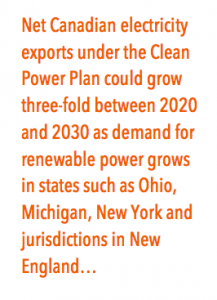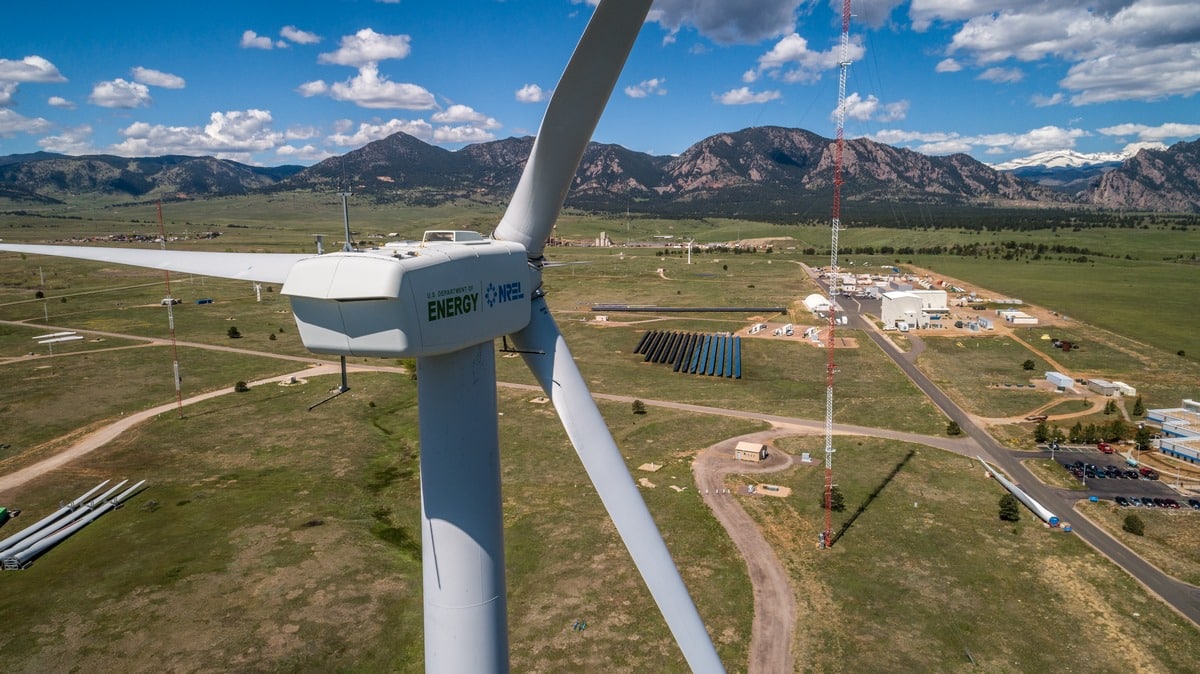
Originally published in the Toronto Star tablet edition, Star Touch.
By Tyler Hamilton
As Canada’s petroleum sector struggles with the reality that sub-$30 (U.S.) oil could be here for some time, the country’s power sector is prepping for a dramatic increase in U.S. demand for clean electricity.
Call it a shift from pipelines to power lines.
Action on climate change is the reason — more specifically, U.S. President Barack Obama’s Clean Power Plan, which aims to slash carbon dioxide emissions from power plants by a third by 2030.
The plan is expected to triple the flow of Canadian electricity into Midwestern and northeastern border states, part of a broader U.S. effort to comply with the international climate obligations that 196 countries agreed to in Paris.
Stakeholders from the Canadian power sector are calling it a breakthrough. “We are very pleased with the outcome,” said Patrick Brown, director of U.S. affairs with the Canadian Electricity Association (CEA).
 Clean electricity imports from Canada are a multibillion-dollar opportunity, but have typically not counted toward state-level renewable energy mandates. After being heavily lobbied, however, the U.S. Environmental Protection Agency recognized imported power, including hydroelectricity, as an important way for states to comply with the new federal emission rules.
Clean electricity imports from Canada are a multibillion-dollar opportunity, but have typically not counted toward state-level renewable energy mandates. After being heavily lobbied, however, the U.S. Environmental Protection Agency recognized imported power, including hydroelectricity, as an important way for states to comply with the new federal emission rules.
Brown said 80 per cent of electricity generated in Canada is emission-free, versus about 20 per cent south of the border. “That’s a real competitive advantage that we believe the Canadian government and provinces need to leverage,” said Brown, adding that an education effort is underway to make state officials more aware of the import option.
The North American Electric Reliability Corporation, which monitors and regulates grid stability in Canada and the U.S., estimated in a report last April that net Canadian electricity exports under the Clean Power Plan could grow three-fold between 2020 and 2030 as demand for renewable power grows in states such as Ohio, Michigan, New York and jurisdictions in New England.
In 2014, such exports represented $3 billion in cross-border trade, meaning the market could be worth $9 billion annually within the next 15 years. The projections are consistent with the preliminary findings of a new high-level report prepared by Boston-based consultancy London Economics International.
“States could decide they don’t want Canadian power, as there’s nothing in the plan that says they should use it. But it does encourage states to look in that direction,” said Andrew Finn, an associate of the Canada Institute at the Woodrow Wilson International Center for Scholars in Washington, D.C.
Finn has spent the past few years pointing to Canada as something more than just the oil sands and pipeline projects, both of which have overshadowed the hydro import option.
“Frankly, the Keystone XL pipeline project took so much oxygen out of the room, but with that out of the way this idea has more room to breath,” he added.
Longer term, some observers say the size of the export market has potential to reach $40 billion a year. Jatin Nathwani, a professor of engineering and environment at the University of Waterloo, estimates that clean electricity trade to the U.S. could soar 10- to 20-fold over the next few decades as part of a continental-wide effort to reduce greenhouse-gas emissions.
“Such an epochal change is conceivable over a 30- to 50-year timeframe consistent with the timelines for achieving a low-carbon economy,” Nathwani argued in a 2014 analysis that was featured in a report from the Canadian Academy of Engineering.
But the transition from pipelines to power lines comes with its own set of challenges, not unlike those experienced by Keystone XL proponents. Long distances and sometimes rough geography make for high upfront infrastructure costs and considerable risk, especially in the face of any political or public opposition to transmission infrastructure routes.
The fact that the constitution gives the provinces authority over electricity generation and transmission has historically been a sticking point.
“Support for expansion of electricity generation and transmission facilities — on a vastly increased scale — as part of a deliberate national ‘export driven’ strategy is either limited or all too often met with derision or outright hostility,” Nathwani wrote.
Still, the opportunity could prove irresistible. As more sub-national jurisdictions move to price carbon, and as more vehicles and industrial activities switch to running on electricity, power consumption is expected to rise in the United States faster than domestic developers can keep up.
The International Energy Agency, meanwhile, has warned in one scenario that the accelerated retirement of aging U.S. nuclear reactors could see nuclear power supply drop by as much as 70 per cent by 2040.
“The demand for electricity is going to keep going up,” said Dan Woynillowicz, policy director at Clean Energy Canada. He added that in a post-Paris world it will need to be low-carbon electricity, which bodes well for Canada.
“We need to get that message out in the same way we’ve had that full offensive championing the oil sands,” Woynillowicz said. “Imagine if we took that same level of effort to promote clean electricity exports?”
That’s exactly what some observers expect Prime Minister Justin Trudeau will do when he visits the White House for a state dinner with Obama. The two leaders have already indicated that closer co-operation on climate action and energy policy will be part of their discussion.
As for what Trudeau should do to stimulate investment on the Canadian side, Woynillowicz said it comes down to reducing risk and creating market certainty. That means creating political and financial supports, such as federal loan guarantees, and rallying the Canadian public behind the idea.
“Hopefully the Canadian government has learned some lessons in light of its experience on the pipeline side,” he said.
This article was part of a series produced in partnership by the Toronto Star and Tides Canada to address a range of pressing climate issues in Canada leading up to and following the UN Paris climate summit. Tides Canada is supporting this partnership to increase public awareness and dialogue around the impacts of climate change on Canada’s economy and communities. The Toronto Star had full editorial control and responsibility to ensure stories are rigorously edited in order to meet its editorial standards.
SOURCE: CLEAN | BREAK – Read entire story here.







